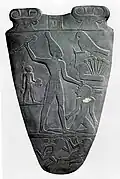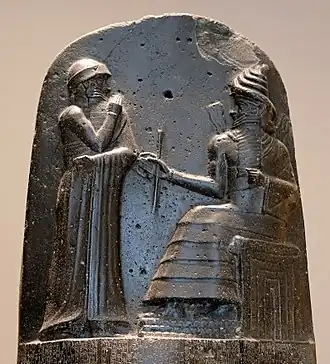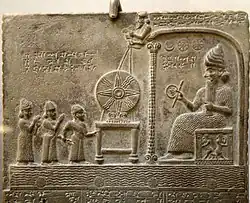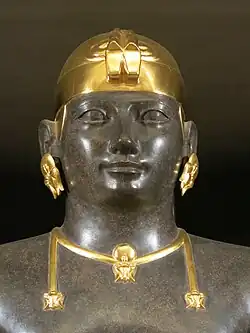Naqada III is the last phase of the Naqada culture of ancient Egyptian prehistory , dating from approximately 3200 to 3000 BC (Petrie Sequence Dates SD 63–76).[ 6] state formation , which began in Naqada II , became highly visible, with named kings heading powerful polities . Naqada III is often referred to as Dynasty 0 or the Protodynastic Period to reflect the presence of kings at the head of influential states, although, in fact, the kings involved would not have been a part of a dynasty. In this period, those kings' names were inscribed in the form of serekhs on a variety of surfaces including pottery and tombs. The period was characterized by constant conflict with the people of the Nile Delta , probably for the control of valuable trade routes with the Levant .[ 7]
The periodization of the Naqada Culture was originally developed by Flinders Petrie in the early 1900s.[ 8] [ 9] [ 10]
History The Protodynastic Period in ancient Egypt was characterised by an ongoing process of political unification, culminating in the formation of a single state to begin the Early Dynastic Period . Furthermore, it is during this time that the Egyptian language was first recorded in hieroglyphs . There is also strong archaeological evidence of Egyptian settlements in southern Canaan during the Protodynastic Period, which are regarded as colonies or trading entrepôts
Archaeologists Pierre de Miroschedji and Moain Sadeq hypothesise that the Egyptian activity in the Levant of this period can be classified in three parts: an area of permanent settlement including Tell es-Sakan (which may have been the administrative centre) and En Besor ; an area extending north along the coast of seasonal habitation, and beyond this to the east and further north was an area of interaction between the Egyptians and the Canaanites.[ 11]
State formation began during this era and perhaps even earlier. Various small city-states arose along the Nile . Centuries of conquest then reduced Upper Egypt to three major states: Thinis , Naqada , and Nekhen . Sandwiched between Thinis and Nekhen, Naqada was the first to fall. Thinis then conquered Lower Egypt . Nekhen's relationship with Thinis is uncertain, but these two states may have merged peacefully, with the Thinite royal family ruling all of Egypt. The Thinite kings were buried at Abydos in the Umm el-Qa'ab cemetery.
Early Egyptologists such as Flinders Petrie were proponents of the Dynastic race theory which hypothesised that the first Egyptian chieftains and rulers were themselves of Mesopotamian origin, but this view has been abandoned among modern scholars.[ 12] [ 13] [ 14]
Dynasty 0 Name of King Iry-Hor , Dynasty 0 , Eastern Kom, Tell el-Farkha .[ 15] The Egyptian rulers of the period belong to the so-called "Dynasty 0", and may have ruled over some parts of Upper Egypt. They include rather obscure rulers such as Crocodile , Iry-Hor , Ka , and perhaps by the king Scorpion II , whose name may refer to, or be derived from, the goddess Serket , a special early protector of other deities and the rulers.. The period ended with the rise of Narmer , who became the first king of the First Dynasty and the first unifier of Egypt.
For Upper Egypt in the south, the following Dynasty 0 rulers have been listed: A Finger Snail Fish Elephant Stork Bull Scorpion I Crocodile Iry-Hor , Ka , Scorpion II Narmer / Menes
For Lower Egypt in the north, the following Dynasty 0 rulers have been listed: Hedju Hor Ny-Hor Ni-Neith Hat-Hor Pu Hsekiu Khayu Tiu Thesh Neheb Wazner Mekh Double Falcon , Wash
Technological innovations Naqada III extended all over Egypt and was characterized by some notable firsts:
And at best, a notable second:
According to the Egypt's Ministry of Antiquities, in February, 2020, Egyptian archaeologists have uncovered 83 tombs dating back to 3,000 B.C, known as the Naqada III period. Various small ceramic pots in different shapes and some sea shells, makeup tools, eyeliner pots, and jewels were also revealed in the burial.[ 19] [ 20]
Decorative cosmetic palettes During Naqada III, the highly decorated ivory sculptures of Naqada II were replaced by decorated greywacke palettes.[ 21] Hunters Palette .
Hunters Palette , circa 3100 BC
"Four Dogs Palette" (3300–3100 BC)
Fragment of a ceremonial palette illustrating a man and a type of staff, ca. 3200–3100 BC
Duck-shaped palette
The
Battlefield Palette , possibly showing the subjection of the people of the
Buto-Maadi culture , by the Egyptian rulers of Naqada III, circa 3100 BC.
[ 22] Man in patterned and fringed dress, holding a naked prisoner, in the
Battlefield Palette , circa 3100 BC.
[ 23] [ 24] [ 22] Fragment of a palette, 3200–2800 BC.
Pottery vessels
Other artifacts
See also
References ^ "tell el-farkha" . Egypt Museum .^ Ciałowicz, Krzysztof M. (2012). "Votive figurines from Tell el-Farkha and their counterparts" . Archéo-Nil . 22 (1): 88– 90. doi :10.3406/arnil.2012.1044 . ^ The Wisdom of Thoth: Magical Texts in Ancient Mediterranean Civilisations ISBN 978-1784912475 . Golden figures depicting most probably a Pre-dynastic ruler and his son and heir, which are the oldest known in Egypt. ^ Hendrickx, Stan (1996). Spencer, A.J. (ed.). "The relative chronology of the Naqada culture: Problems and possibilities" . Aspects of Early Egypt . London: British Museum Press: 64. ^ "Naqada chronology" . www.ucl.ac.uk . University College, London.^ Josephson, Jack (29 November 2015). "Naqada IId, Birth of an Empire" . Journal of the American Research Center in Egypt (51): 165. doi :10.5913/JARCE.51.2015.A007 . Most of Dynasty 0 was spent at war with the Delta people, presumably to control and protect trade routes from the Levant, the source of invaluable wood, wine, and other commodities. ^ Petrie, W.M.F., "Diospolis Parva, The cemeteries of Abadiyeh and Hu. 1898-1899", EEF 20, London, 1901 ^ Petrie, W.M.F., "Corpus of Prehistoric pottery and palettes", BSAE&ERA 32, London, 1921 ^ [1] Hendrickx, Stan, "Naqada IIIA-B, a crucial phase in the relative chronology of the Naqada culture", Archéo-Nil 21.1, pp. 65-80, 2011^ de Miroschedji, Pierre; Sadeq, Moain (2005), "The frontier of Egypt in the Early Bronze Age: preliminary soundings at Tell es-Sakan (Gaza Strip)", in Clarke, Joanne (ed.), Archaeological Perspectives on the Transmission and Transformation of Culture in the Eastern Mediterranean 155– 169, JSTOR j.ctv310vqks.24 ^ Derry, D.E. (1956). "The Dynastic Race in Egypt". Journal of Egyptian Archaeology 42 : 80– 85. doi :10.1177/030751335604200111 . S2CID 194596267 . ^ Wilkinson, Toby (1999). Early dynastic Egypt . London: Routledge. p. 15. ISBN 0415186331 . ^ Zakrzewski, Sonia R. (2007). Population continuity or population change: Formation of the ancient Egyptian state . Highfield, Southampton: Department of Archaeology, University of Southampton. ^ Cialowicz, Krzysztof M. (2011). "6. The Early-Dynastic/Pre-Dynastic period at Tell al-Fakrah". Before the pyramids: the origins of Egyptian civilization; [publ. in conjunction with the Exhibition Before the Pyramids: The Origins of Egyptian Civilization, March 28 - December 31, 2011] (PDF) . Chicago, Ill: The Oriental Institute of the University of Chicago. pp. 63– 64. ISBN 978-1-885923-82-0 . ^ Meza, A.I. (2007) “Neolithic Boats: Ancient Egypt and the Maltese Islands. A Minoan Connection” J-C. Goyon,C. Cardin (Eds.) Actes Du Neuvième Congrès International Des Égyptologues, p. 1287. ^ Robinson, D. (2012). "Review of: Anderson, A., et al. (2010), The Global Origins and Development of Seafaring ". International Journal of Nautical Archaeology . 41 (1): 206– 208. doi :10.1111/j.1095-9270.2011.00333_2.x . S2CID 162515460 . ^ Geggel, Laura (21 February 2020). "Dozens of ancient Egyptian graves found with rare clay coffins" . livescience.com . Retrieved 2020-06-28 . ^ "الكشف عن 83 مقبرة أثرية بمنطقة آثار كوم الخلجان بمحافظة الدقهلية" . اليوم السابع . 2020-02-12. Retrieved 2020-06-28 .^ Josephson, Jack (29 November 2015). "Naqada IId, Birth of an Empire" . Journal of the American Research Center in Egypt (51): 169. doi :10.5913/JARCE.51.2015.A007 . By Naqada IIIa (Dynasty 0) the manufacture of superbly carved small ivories was supplanted by the introduction of elaborately decorated greywacke palettes. ^ a b Brovarski, Edward. REFLECTIONS ON THE BATTLEFIELD AND LIBYAN BOOTY PALETTES ^ "A little higher, a figure dressed in a long, embroidered robe leads a prisoner." in Bazin, Germain (1976). The History of World Sculpture ISBN 978-0-89009-089-3 . ^ Kelder, Jorrit (2017). Narmer, scorpion and the representation of the early Egyptian court: Published in Origini n. XXXV/2013. Rivista annuale del Dipartimento di Scienze dell'Antichità – "Sapienza" Università di Roma Preistoria e protostoria delle civiltà antiche – Prehistory and protohistory of ancient civilizations ISBN 978-88-492-4791-6 . ^ Tamás, Bács (2017). Bevezetés az ókori Egyiptom művészetébe (PDF) . Budapest: Gondolat Kiadó. p. 16, Fig.6. ISBN 978 963 693 791 1 .
Further reading
External links Wikimedia Commons has media related to
Naqada III .
Territories/[ 1] [ 2] [ 3] [ 4] [ 5] Egypt Canaan Ebla Mari Kish /Assur Akshak /Akkad Uruk Adab Umma Lagash Ur Elam 4000–3200 BCE Naqada I Naqada II Egypt–Mesopotamia relations Pre-Dynastic period (4000–2900 BCE) Susa I Uruk period Anu Ziggurat , 4000 BCE)Susa II 3200–3100 BCE Upper Egypt Finger Snail Fish Pen-Abu Animal Stork Canide Bull Scorpion I Shendjw Iry-Hor Ka Scorpion II Narmer / Menes Lower Egypt Hedju Hor Ny-Hor Hsekiu Khayu Tiu Thesh Neheb Wazner Nat-Hor Mekh Double Falcon Wash 3100–2900 BCE Early Dynastic Period First Dynasty of Egypt Narmer Palette Narmer Menes Neithhotep ♀ (regent) Hor-Aha Djer Djet Merneith ♀ (regent) Den Anedjib Semerkhet Qa'a Sneferka Horus Bird Canaanites Jemdet Nasr period Proto-Elamite Susa III ) 2900 BCE Second Dynasty of Egypt Hotepsekhemwy Nebra/Raneb Nynetjer Ba Nubnefer Horus Sa Weneg-Nebty Wadjenes Senedj Seth-Peribsen Sekhemib-Perenmaat Neferkara I Neferkasokar Hudjefa I Khasekhemwy Early Dynastic Period I (2900–2700 BCE) First Eblaite First kingdom of Mari Kish I dynastyJushur , Kullassina-bel Nangishlishma ,En-tarah-ana Babum , Puannum , Kalibum 2800 BCE
Kalumum Zuqaqip Atab Mashda Arwium Etana Balih En-me-nuna Melem-Kish Barsal-nuna Uruk I dynastyMeshkiangasher Enmerkar ("conqueror of Aratta ") 2700 BCE Early Dynastic Period II (2700–2600 BCE) Zamug , Tizqar , Ilku Iltasadum Lugalbanda Dumuzid, the Fisherman Enmebaragesi ("made the land of Elam submit")[ 6] Aga of Kish Gilgamesh Old Elamite period Indo-Mesopotamia relations 2600 BCE Third Dynasty of Egypt Djoser Egyptian pyramids )Sekhemkhet Sanakht Nebka Khaba Qahedjet Huni Early Dynastic Period III (2600–2340 BCE) Sagisu Kish II dynastyUhub Mesilim Ur-Nungal Udulkalama Labashum Lagash En-hegal Lugal- Ur A-Imdugud Ur-Pabilsag Meskalamdug Puabi )Akalamdug Enun-dara-anna Mesh-he Melem-ana Lugal-kitun Adab Nin-kisalsi Lugal-dalu 2575 BCE Old Kingdom of Egypt Fourth Dynasty of Egypt Snefru Khufu Djedefre Khafre Bikheris Menkaure Shepseskaf Thamphthis Ur I dynasty Mesannepada 2500 BCE Phoenicia (2500–539 BCE) Second kingdom of Mari Ikun-Shamash Iku-Shamagan Ansud Sa'umu Ishtup-Ishar Ikun-Mari Iblul-Il Kish III dynasty Ku-Baba ♀ Akshak dynasty Uruk II dynastyEnsha- Mug-si Umma I dynastyPabilgagaltuku Lagash I dynastyUr-Nanshe Akurgal A'annepada Meskiagnun Elulu Balulu Awan dynasty Peli Tata Ukkutahesh Hishur 2450 BCE Fifth Dynasty of Egypt Userkaf Sahure Neferirkare Kakai Neferefre Shepseskare Nyuserre Ini Menkauhor Kaiu Djedkare Isesi Unas Enar-Damu Ush Enakalle Elamite invasions[ 6] Shushun-Tarana Napi-Ilhush 2425 BCE Kun-Damu Eannatum 2400 BCE Adub-DamuIgrish-Halam Irkab-Damu Kish IV dynastyPuzur-Suen Ur-Zababa Urur Lugal-kinishe-dudu Lugal-kisalsi E-iginimpa'e Meskigal Ur-Lumma Il Gishakidu Bara-irnun ) Enannatum Entemena Enannatum II Enentarzi Ur II dynastyKikku-Siwe-Temti 2380 BCE Sixth Dynasty of Egypt Teti Userkare Pepi I Merenre Nemtyemsaf I Pepi II Merenre Nemtyemsaf II Netjerkare Siptah Adab dynastyLugal-Anne-Mundu 2370 BCE Isar-Damu Enna-DaganIshqi-Mari Invasion by Mari [ 6] Ukush Lugalanda Urukagina Luh-ishan 2350 BCE Puzur-Nirah Uruk III dynastyLugal-zage-si 2340 BCE Akkadian Period (2340–2150 BCE) Akkadian Empire Sargon of Akkad Rimush Manishtushu Akkadian Governors: Eshpum Ilshu-rabi Epirmupi Ili-ishmani 2250 BCE Naram-Sin Lugal-ushumgal 2200 BCE First Intermediate Period Seventh Dynasty of Egypt Eighth Dynasty of Egypt Menkare Neferkare II Neferkare Neby Djedkare Shemai Neferkare Khendu Merenhor Neferkamin Nikare Neferkare Tereru Neferkahor Neferkare Pepiseneb Neferkamin Anu Qakare Ibi Neferkaure Neferkauhor Neferirkare Second Eblaite Third kingdom of Mari Shakkanakku Ishma-Dagan Shar-Kali-Sharri Igigi , Imi , Nanum , Ilulu (3 years)Dudu Shu-turul Uruk IV dynastyUr-nigin Ur-gigir Lagash II dynastyPuzer-Mama Ur-Ningirsu I Pirig-me Hishep-ratep Khita Puzur-Inshushinak 2150 BCE Ninth Dynasty of Egypt Meryibre Khety Neferkare VII Nebkaure Khety Setut Ur III period (2150–2000 BCE) Nûr-Mêr Ishtup-Ilum Ishgum-Addu Apil-kin Gutian dynasty La-erabum Si'um Kuda (Uruk) Umma II dynastyLugalannatum Ur-Baba Gudea Ur-Ningirsu Ur-gar Nam-mahani Tirigan 2125 BCE Tenth Dynasty of Egypt Meryhathor Neferkare VIII Wahkare Khety Merikare
Uruk V dynastyUtu-hengal 2100 BCE (Vassals of UR III) Iddi-ilum Ili-Ishar Tura-Dagan Puzur-Ishtar [ 7] Ur III dynasty Ur-Nammu Shulgi Amar-Sin Shu-Sin 2025–1763 BCE Amorite invasionsIbbi-Sin Elamite invasionsKindattu (Shimashki Dynasty ) Middle Kingdom of Egypt Eleventh Dynasty of Egypt Mentuhotep I Intef I Intef II Intef III Mentuhotep II Mentuhotep III Mentuhotep IV Third Eblaite Amorites )Ibbit-Lim Immeya Indilimma (Amorite Shakkanakkus )Hanun-Dagan Lim Dynasty of Mari Amorites )Yaggid-Lim Yahdun-Lim Yasmah-Adad Zimri-Lim (Queen Shibtu ) Old Assyria Puzur-Ashur I Shalim-ahum Ilu-shuma Erishum I Ikunum Sargon I Puzur-Ashur II Naram-Sin Erishum II Isin-Larsa period Amorites )Dynasty of Isin Ishbi-Erra Shu-Ilishu Iddin-Dagan Ishme-Dagan Lipit-Ishtar Ur-Ninurta Bur-Suen Lipit-Enlil Erra-imitti Enlil-bani Zambiya Iter-pisha Ur-du-kuga Suen-magir Damiq-ilishu Dynasty of Larsa : Naplanum Emisum Samium Zabaia Gungunum Abisare Sumuel Nur-Adad Sin-Iddinam Sin-Eribam Sin-Iqisham Silli-Adad Warad-Sin Rim-Sin I (...) Rim-Sin II Uruk VI dynasty : Alila-hadum Sumu-binasa Naram-Sin of Uruk Sîn-kāšid Sîn-iribam Sîn-gāmil Ilum-gamil An-am Irdanene Rîm-Anum Nabi-ilišu Sukkalmah dynasty Siwe-Palar-Khuppak Twelfth Dynasty of Egypt Amenemhat I Senusret I Amenemhat II Senusret II Senusret III Amenemhat III Amenemhat IV Sobekneferu ♀ 1800–1595 BCE Thirteenth Dynasty of Egypt Fourteenth Dynasty of Egypt Abraham Biblical )Kings of Byblos Kings of Tyre Kings of Sidon Yamhad Yamhad dynasty )Old Assyria (Shamshi-Adad dynastyShamshi-Adad I Ishme-Dagan I Mut-Ashkur Rimush Asinum Ashur-dugul Ashur-apla-idi Nasir-Sin Sin-namir Ipqi-Ishtar Adad-salulu Adasi Puzur-Sin Ashur-dugul Ashur-apla-idi Nasir-Sin Sin-namir Ipqi-Ishtar Adad-salulu Adasi Adaside dynasty Bel-bani Libaya Sharma-Adad I Iptar-Sin Bazaya Lullaya Shu-Ninua Sharma-Adad II Erishum III Shamshi-Adad II Ishme-Dagan II Shamshi-Adad III Ashur-nirari I Puzur-Ashur III Enlil-nasir I Nur-ili Ashur-shaduni Ashur-rabi I Ashur-nadin-ahhe I Enlil-Nasir II Ashur-nirari II Ashur-bel-nisheshu Ashur-rim-nisheshu Ashur-nadin-ahhe II
First Babylonian dynasty Amorites )Sumu-abum Sumu-la-El Sabium Apil-Sin Sin-Muballit Hammurabi Samsu-iluna Abi-Eshuh Ammi-Ditana Ammi-Saduqa Samsu-Ditana Early Kassite rulers Second Babylonian dynastySealand Dynasty ") Ilum-ma-ili Itti-ili-nibi Damqi-ilishu Ishkibal Shushushi Gulkishar m DIŠ+U-ENPeshgaldaramesh Ayadaragalama Akurduana Melamkurkurra Ea-gamil Second Intermediate Period Sixteenth Abydos Seventeenth
Fifteenth Dynasty of Egypt Hyksos ")Pharaoh Ahmose I slaying a Hyksos Semqen 'Aper-'Anati Sakir-Har Khyan Apepi Khamudi Mitanni Kirta Shuttarna I Baratarna 1531–1155 BCE Tutankhamun New Kingdom of Egypt Eighteenth Dynasty of Egypt Ahmose I Amenhotep I Third Babylonian dynasty (Kassites ) Agum-Kakrime Burnaburiash I Kashtiliash III Ulamburiash Agum III Karaindash Kadashman-Harbe I Kurigalzu I Kadashman-Enlil I Burna-Buriash II Kara-hardash Nazi-Bugash Kurigalzu II Nazi-Maruttash Kadashman-Turgu Kadashman-Enlil II Kudur-Enlil Shagarakti-Shuriash Kashtiliash IV Enlil-nadin-shumi Kadashman-Harbe II Adad-shuma-iddina Adad-shuma-usur Meli-Shipak II Marduk-apla-iddina I Zababa-shuma-iddin Enlil-nadin-ahi Middle Elamite period (1500–1100 BCE)Kidinuid dynasty Igehalkid dynasty Untash-Napirisha
Thutmose I Thutmose II Hatshepsut ♀ Thutmose III Amenhotep II Thutmose IV Amenhotep III Akhenaten Smenkhkare Neferneferuaten ♀ Tutankhamun Ay Horemheb Hittite Empire Suppiluliuma I Mursili II Muwatalli II Mursili III Hattusili III Tudhaliya IV Suppiluliuma II Ugarit (vassal of Hittites) Nineteenth Dynasty of Egypt Ramesses I Seti I Ramesses II Merneptah Amenmesses Seti II Siptah Tausret ♀ Elamite Empire Shutrukid dynasty Shutruk-Nakhunte 1155–1025 BCE Twentieth Dynasty of Egypt Setnakhte Ramesses III Ramesses IV Ramesses V Ramesses VI Ramesses VII Ramesses VIII Ramesses IX Ramesses X Ramesses XI Third Intermediate Period Twenty-first Dynasty of Egypt Smendes Amenemnisu Psusennes I Amenemope Osorkon the Elder Siamun Psusennes II
Phoenicia Kings of Byblos Kings of Tyre Kings of Sidon Kingdom of Israel Saul Ish-bosheth David Solomon Syro-Hittite states Carchemish Tabal Middle Assyria Eriba-Adad I Ashur-uballit I Enlil-nirari Arik-den-ili Adad-nirari I Shalmaneser I Tukulti-Ninurta I Ashur-nadin-apli Ashur-nirari III Enlil-kudurri-usur Ninurta-apal-Ekur Ashur-dan I Ninurta-tukulti-Ashur Mutakkil-Nusku Ashur-resh-ishi I Tiglath-Pileser I Asharid-apal-Ekur Ashur-bel-kala Eriba-Adad II Shamshi-Adad IV Ashurnasirpal I Shalmaneser II Ashur-nirari IV Ashur-rabi II Ashur-resh-ishi II Tiglath-Pileser II Ashur-dan II Fourth Babylonian dynasty ("Second Dynasty of Isin ") Marduk-kabit-ahheshu Itti-Marduk-balatu Ninurta-nadin-shumi Nebuchadnezzar I Enlil-nadin-apli Marduk-nadin-ahhe Marduk-shapik-zeri Adad-apla-iddina Marduk-ahhe-eriba Marduk-zer-X Nabu-shum-libur Neo-Elamite period (1100–540 BCE) 1025–934 BCE Fifth, Sixth, Seventh, Babylonian dynasties ("Period of Chaos") Simbar-shipak Ea-mukin-zeri Kashshu-nadin-ahi Eulmash-shakin-shumi Ninurta-kudurri-usur I Shirikti-shuqamuna Mar-biti-apla-usur Nabû-mukin-apli 911–745 BCE Twenty-second Dynasty of Egypt Shoshenq I Osorkon I Shoshenq II Takelot I Osorkon II Shoshenq III Shoshenq IV Pami Shoshenq V Pedubast II Osorkon IV Twenty-third Dynasty of Egypt Harsiese A Takelot II Pedubast I Shoshenq VI Osorkon III Takelot III Rudamun Menkheperre Ini Twenty-fourth Dynasty of Egypt Tefnakht Bakenranef
Kingdom of Samaria Kingdom of Judah Neo-Assyrian Empire Adad-nirari II Tukulti-Ninurta II Ashurnasirpal II Shalmaneser III Shamshi-Adad V Shammuramat ♀ (regent) Adad-nirari III Shalmaneser IV Ashur-Dan III Ashur-nirari V Eight Babylonian Dynasty Ninurta-kudurri-usur II Mar-biti-ahhe-iddina Shamash-mudammiq Nabu-shuma-ukin I Nabu-apla-iddina Marduk-zakir-shumi I Marduk-balassu-iqbi Baba-aha-iddina (five kings) Ninurta-apla-X Marduk-bel-zeri Marduk-apla-usur Eriba-Marduk Nabu-shuma-ishkun Nabonassar Nabu-nadin-zeri Nabu-shuma-ukin II Nabu-mukin-zeri Humban-Tahrid dynasty Urtak Teumman Ummanigash Tammaritu I Indabibi Humban-haltash III 745–609 BCE Twenty-fifth Dynasty of Egypt Taharqa Black Pharaohs ")Piye Shebitku Shabaka Taharqa Tanutamun Neo-Assyrian Empire (Sargonid dynasty ) Tiglath-Pileser † Shalmaneser † Marduk-apla-iddina II Sargon † Sennacherib † Marduk-zakir-shumi II Marduk-apla-iddina II Bel-ibni Ashur-nadin-shumi † Nergal-ushezib Mushezib-Marduk Esarhaddon † Ashurbanipal Ashur-etil-ilani Sinsharishkun Sin-shumu-lishir Ashur-uballit II
Assyrian conquest of Egypt Assyrian conquest of Elam 626–539 BCE Late Period Twenty-sixth Dynasty of Egypt Necho I Psamtik I Necho II Psamtik II Wahibre Ahmose II Psamtik III Neo-Babylonian Empire Nabopolassar Nebuchadnezzar II Amel-Marduk Neriglissar Labashi-Marduk Nabonidus Median Empire Deioces Phraortes Madyes Cyaxares Astyages 539–331 BCE Twenty-seventh Dynasty of Egypt First Achaemenid conquest of Egypt ) Kings of Byblos Kings of Tyre Kings of Sidon Achaemenid Empire Cyrus Cambyses Darius I Xerxes Artaxerxes I Darius II Artaxerxes II Artaxerxes III Artaxerxes IV Darius III Twenty-eighth Dynasty of Egypt Twenty-ninth Dynasty of Egypt Thirtieth Dynasty of Egypt Thirty-first Dynasty of Egypt 331–141 BCE Argead dynasty and Ptolemaic Egypt Ptolemy I Soter Ptolemy Ceraunus Ptolemy II Philadelphus Arsinoe II ♀ Ptolemy III Euergetes Berenice II Euergetis ♀ Ptolemy IV Philopator Arsinoe III Philopator ♀ Ptolemy V Epiphanes Cleopatra I Syra ♀ Ptolemy VI Philometor Ptolemy VII Neos Philopator Cleopatra II Philometor Soteira ♀ Ptolemy VIII Physcon Cleopatra III ♀ Ptolemy IX Lathyros Cleopatra IV ♀ Ptolemy X Alexander Berenice III ♀ Ptolemy XI Alexander Ptolemy XII Auletes Cleopatra V ♀ Cleopatra VI Tryphaena ♀ Berenice IV Epiphanea ♀ Ptolemy XIII Ptolemy XIV Cleopatra VII Philopator ♀ Ptolemy XV Caesarion Arsinoe IV ♀ Hellenistic Period Seleukos I Nikator Tetradrachm from Babylon Argead dynasty Alexander III Philip III Alexander IV Antigonid dynasty Antigonus I Seleucid Empire Seleucus I Antiochus I Antiochus II Seleucus II Seleucus III Antiochus III Seleucus IV Antiochus IV Antiochus V Demetrius I Alexander III Demetrius II Antiochus VI Dionysus Diodotus Tryphon Antiochus VII Sidetes 141–30 BCE Kingdom of Judea Simon Thassi John Hyrcanus Aristobulus I Alexander Jannaeus Salome Alexandra ♀ Hyrcanus II Aristobulus II Antigonus II Mattathias Alexander II Zabinas Seleucus V Philometor Antiochus VIII Grypus Antiochus IX Cyzicenus Seleucus VI Epiphanes Antiochus X Eusebes Antiochus XI Epiphanes Demetrius III Eucaerus Philip I Philadelphus Antiochus XII Dionysus Antiochus XIII Asiaticus Philip II Philoromaeus Parthian Empire Mithridates I Phraates Hyspaosines Artabanus Mithridates II Gotarzes Mithridates III Orodes I Sinatruces Phraates III Mithridates IV Orodes II Phraates IV Tiridates II Musa Phraates V Orodes III Vonones I Artabanus II Tiridates III Artabanus II Vardanes I Gotarzes II Meherdates Vonones II Vologases I Vardanes II Pacorus II Vologases II Artabanus III Osroes I 30 BCE–116 CE Roman Empire (Roman conquest of Egypt )Province of Egypt Judaea Syria 116–117 CE Province of Mesopotamia under Trajan Parthamaspates of Parthia 117–224 CE Syria Palaestina Province of Mesopotamia Sinatruces II Mithridates V Vologases IV Osroes II Vologases V Vologases VI Artabanus IV 224–270 CE Sasanian Empire Province of Asoristan Coin of Ardashir I, Hamadan mint. Ardashir I Shapur I Hormizd I Bahram I Bahram II Bahram III Narseh Hormizd II Adur Narseh Shapur II Ardashir II Shapur III Bahram IV Yazdegerd I Shapur IV Khosrow Bahram V Yazdegerd II Hormizd III Peroz I Balash Kavad I Jamasp Kavad I Khosrow I Hormizd IV Khosrow II Bahram VI Chobin Vistahm 270–273 CE Palmyrene Empire Vaballathus Zenobia ♀ Antiochus 273–395 CE Roman Empire Province of Egypt Syria Palaestina Syria Province of Mesopotamia 395–618 CE Byzantine Empire Byzantine Egypt Palaestina Prima , Palaestina Secunda Byzantine Syria Byzantine Mesopotamia 618–628 CE (Sasanian conquest of Egypt )Province of Egypt Shahrbaraz Shahralanyozan Shahrbaraz Sasanian Empire Province of Asoristan Khosrow II Kavad II 628–641 CE Byzantine Empire Ardashir III Shahrbaraz Khosrow III Boran ♀ Shapur-i Shahrvaraz Azarmidokht ♀ Farrukh Hormizd Hormizd VI Khosrow IV Boran Yazdegerd III Peroz III Narsieh Byzantine Egypt Palaestina Prima , Palaestina Secunda Byzantine Syria Byzantine Mesopotamia 639–651 CE Muslim conquest of Egypt Muslim conquest of the Levant Muslim conquest of Mesopotamia and Persia

 Hunters Palette, circa 3100 BC
Hunters Palette, circa 3100 BC "Four Dogs Palette" (3300–3100 BC)
"Four Dogs Palette" (3300–3100 BC) Fragment of a ceremonial palette illustrating a man and a type of staff, ca. 3200–3100 BC
Fragment of a ceremonial palette illustrating a man and a type of staff, ca. 3200–3100 BC Duck-shaped palette
Duck-shaped palette Bull Palette, 3100 BC
Bull Palette, 3100 BC![The Battlefield Palette, possibly showing the subjection of the people of the Buto-Maadi culture, by the Egyptian rulers of Naqada III, circa 3100 BC.[22]](./_assets_/The_Battlefield_Palette_3100_BC_-_Joy_of_Museums.jpg) The Battlefield Palette, possibly showing the subjection of the people of the Buto-Maadi culture, by the Egyptian rulers of Naqada III, circa 3100 BC.[22]
The Battlefield Palette, possibly showing the subjection of the people of the Buto-Maadi culture, by the Egyptian rulers of Naqada III, circa 3100 BC.[22]![Man in patterned and fringed dress, holding a naked prisoner, in the Battlefield Palette, circa 3100 BC.[23][24][22]](./_assets_/Man_in_patterned_and_fringed_dress%252C_behind_naked_prisoner%252C_The_Battlefield_Palette_3100_BCE.jpg) Man in patterned and fringed dress, holding a naked prisoner, in the Battlefield Palette, circa 3100 BC.[23][24][22]
Man in patterned and fringed dress, holding a naked prisoner, in the Battlefield Palette, circa 3100 BC.[23][24][22] Fragment of a palette, 3200–2800 BC.
Fragment of a palette, 3200–2800 BC. Naqada III pottery
Naqada III pottery Naqada III vessel
Naqada III vessel Typical Naqada III cylindrical jar
Typical Naqada III cylindrical jar
 Hair Comb Decorated with Rows of Wild Animals 3200–3100 BCE, Naqada III
Hair Comb Decorated with Rows of Wild Animals 3200–3100 BCE, Naqada III![Male statuettes with penile sheaths, Hierakonpolis. Late Predynastic, Naqada III (3300–3000 BC) – Early Dynastic, Dynasty I (3000–2890 BC).[25]](./_assets_/Hierakonpolis_Ivories-_Male_Figurines_(cropped).jpg) Male statuettes with penile sheaths, Hierakonpolis. Late Predynastic, Naqada III (3300–3000 BC) – Early Dynastic, Dynasty I (3000–2890 BC).[25]
Male statuettes with penile sheaths, Hierakonpolis. Late Predynastic, Naqada III (3300–3000 BC) – Early Dynastic, Dynasty I (3000–2890 BC).[25] Female statuettes Hierakonpolis, Hierakonpolis. Late Predynastic, Naqada III (3300–3000 BC) – Early Dynastic, Dynasty I (3000–2890 BC).
Female statuettes Hierakonpolis, Hierakonpolis. Late Predynastic, Naqada III (3300–3000 BC) – Early Dynastic, Dynasty I (3000–2890 BC)..jpg)
._Egyptian_Museum_(Cairo)._30cm_height_(cropped).jpg)





.jpg)

_Colorized_per_source.jpg)





%252C_Hamadan_mint.jpg)